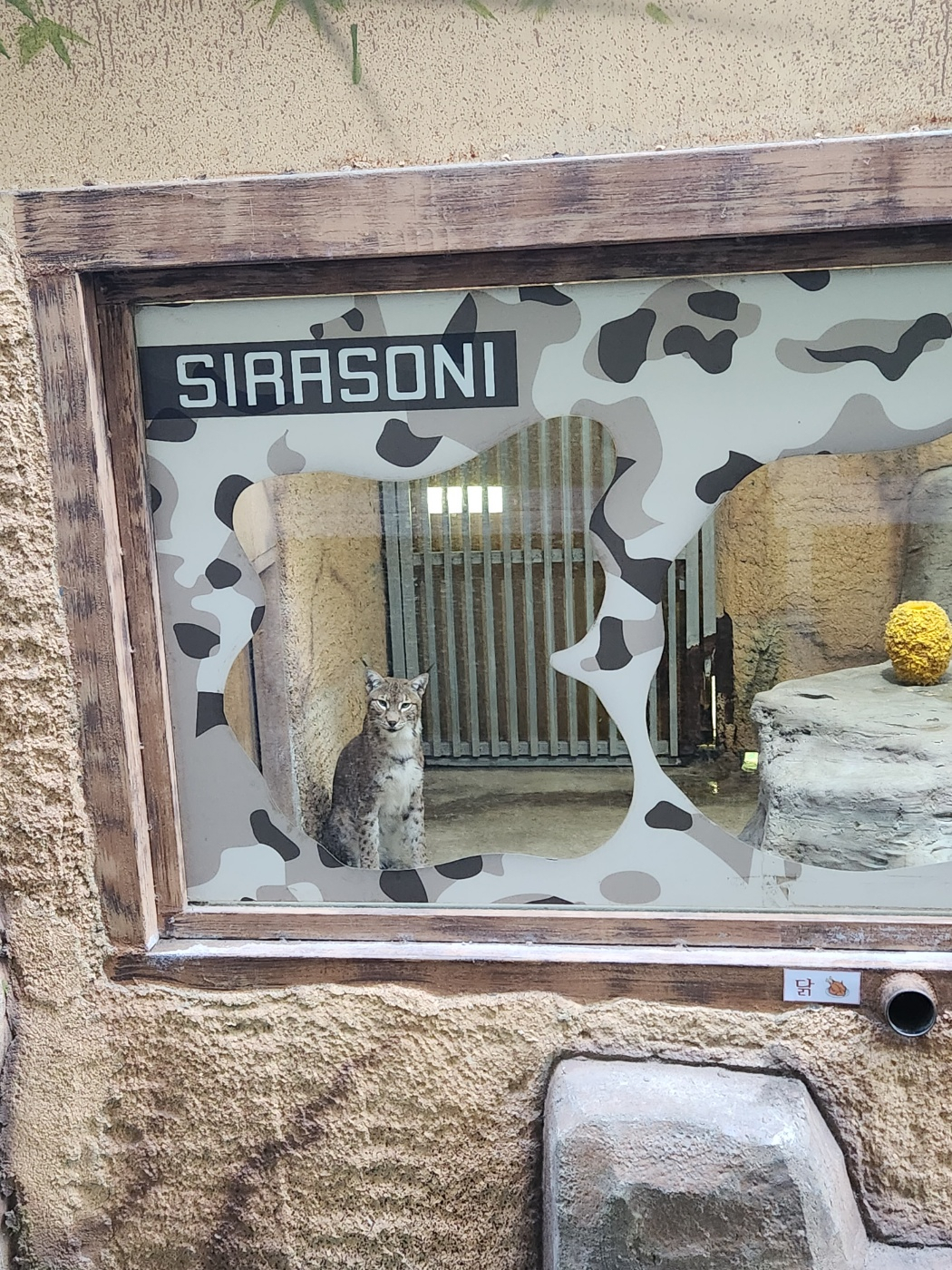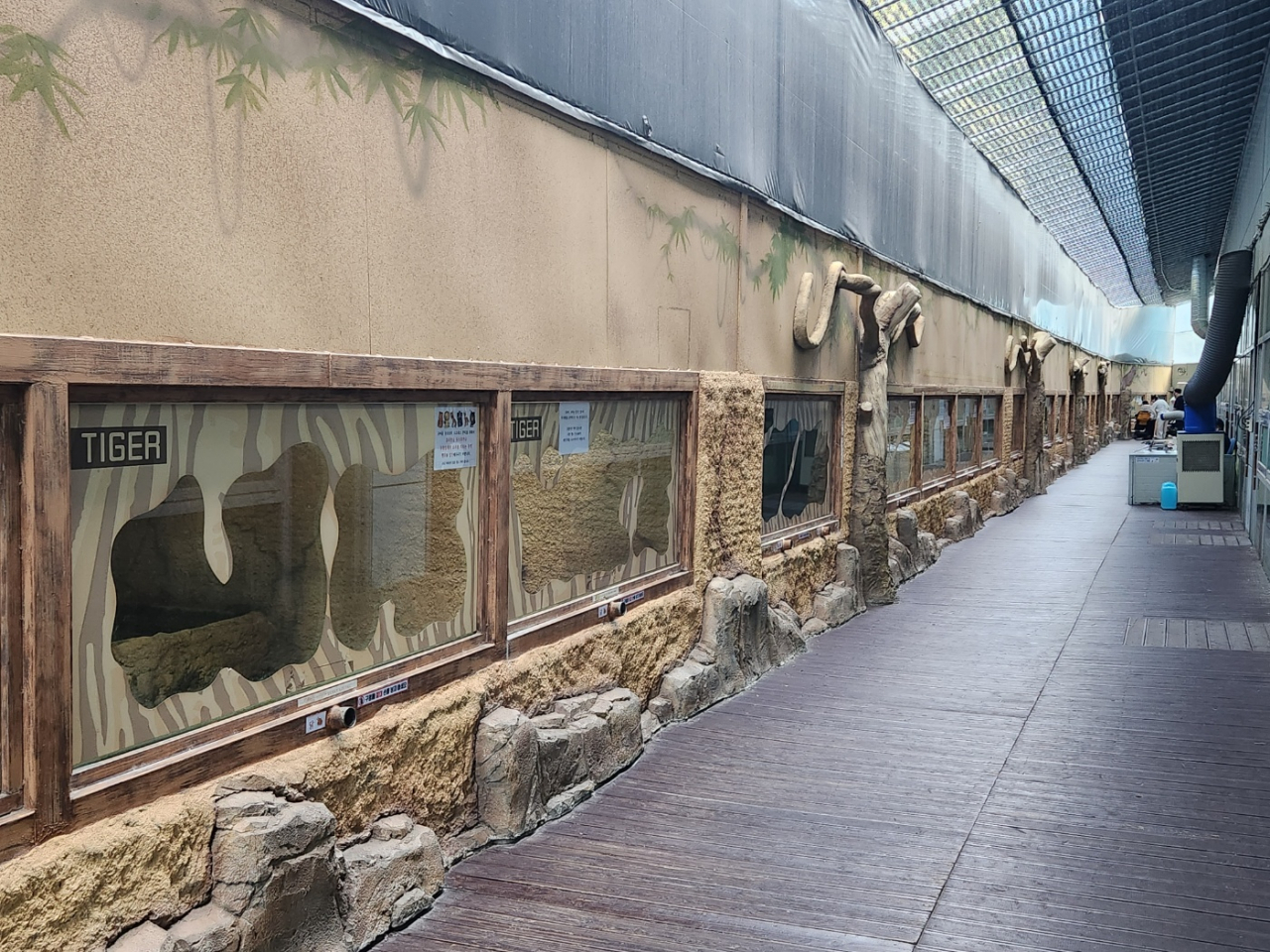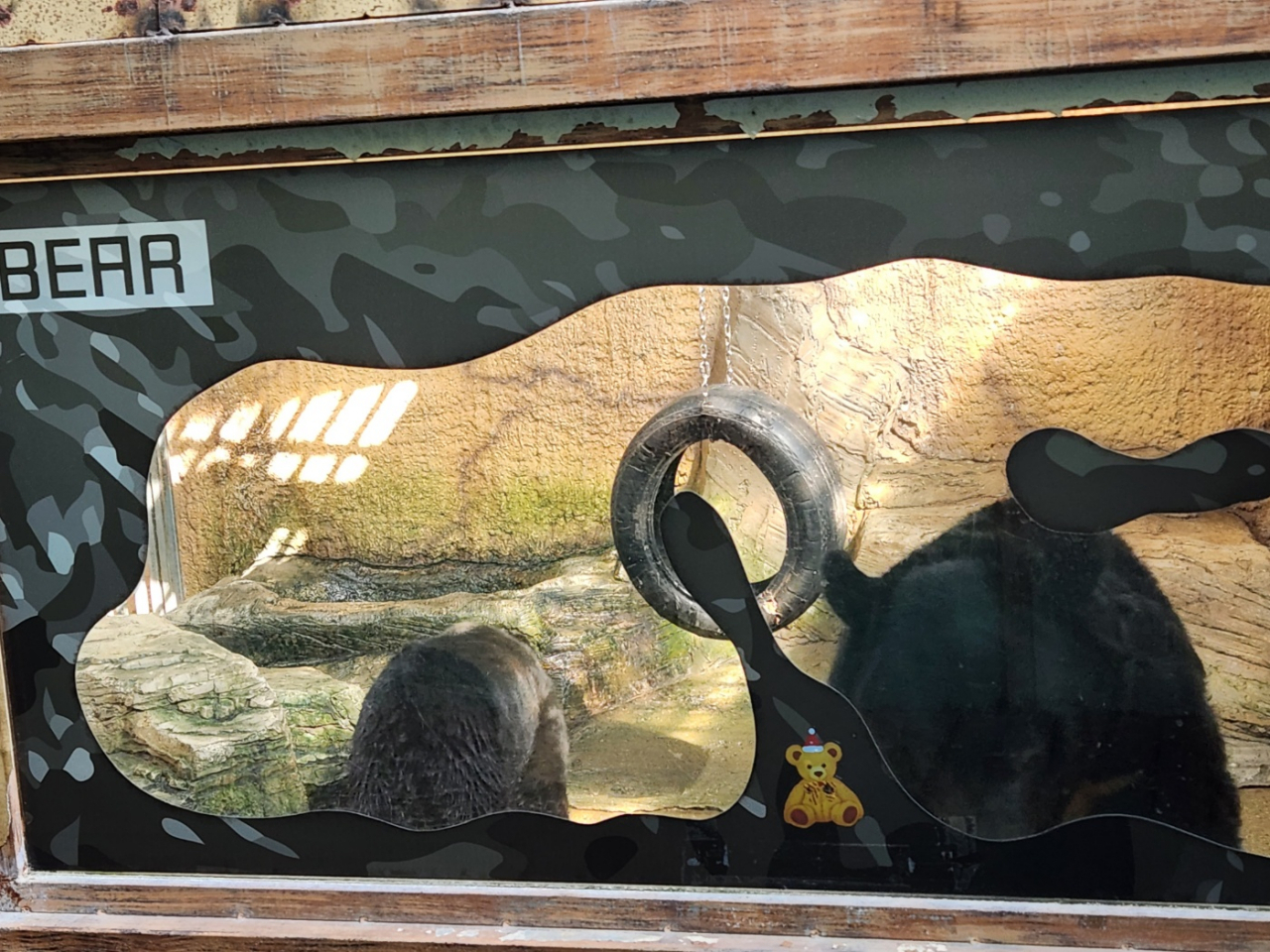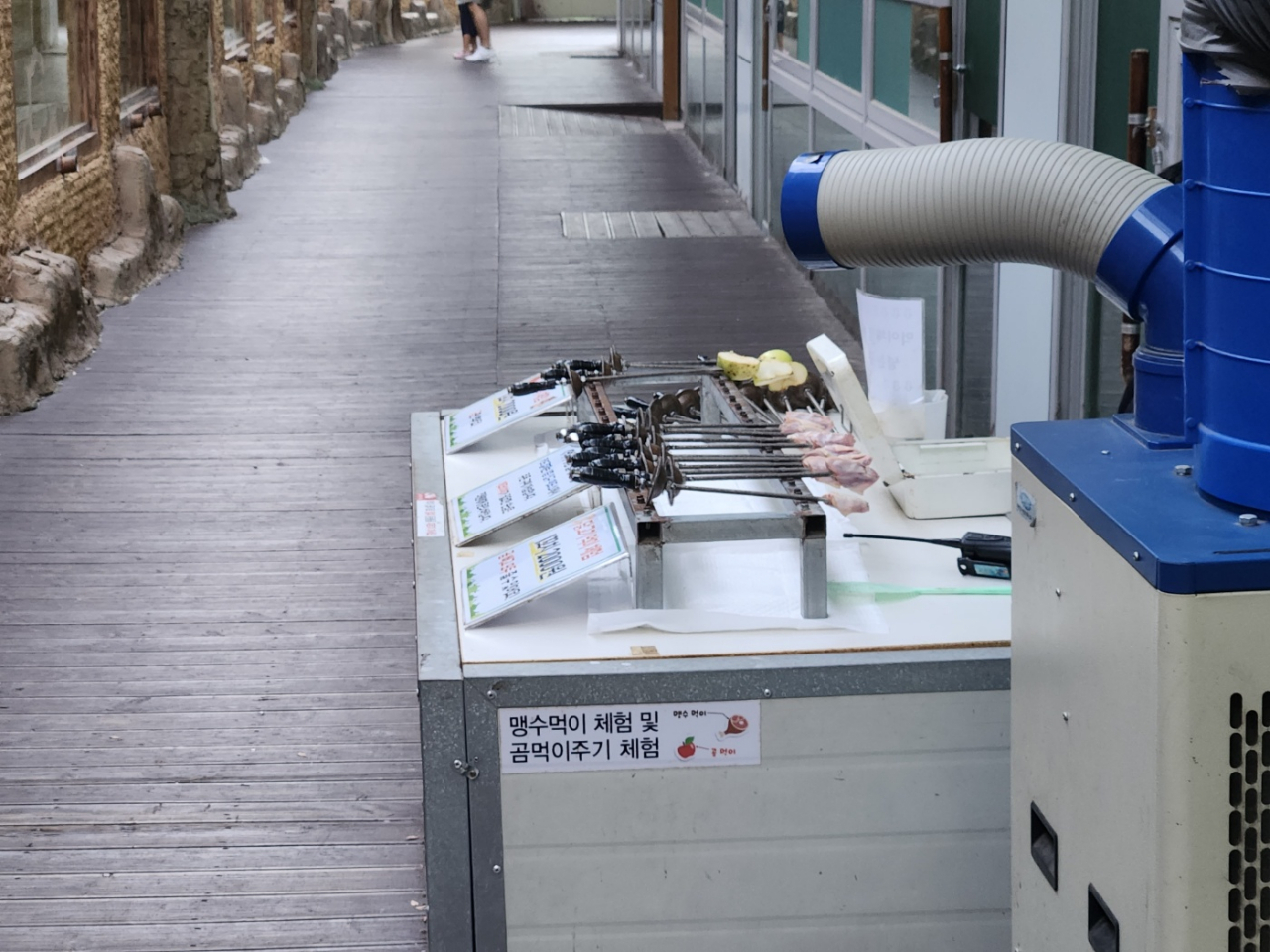 |
A lynx sits inside its enclosure at the zoo at the Daejeon Aquarium in Daejeon. (Yoon Min-sik/The Korea Herald) |
A jaguar paced back and forth within its cage, measuring about 30 square meters in total area. Each time the great cat reached the edge of its enclosure, it reared on its hind legs, as if to attempt a futile climb onto the wall.
Daejeon Aquarium’s “mini zoo,” located on the third floor of the aquarium, recently came under fire on social media for placing its animals in substandard living conditions.
In light of the revision to the Enforcement Degree of the Act on the Management of Zoos and Aquariums slated to take effect on Dec. 14, which will implement a permit system to winnow out underqualified zoos, The Korea Herald visited the controversial zoo in Daejeon.
 |
The predator section of the zoo at the Daejeon Aquarium in Daejeon. (Yoon Min-sik/The Korea Herald) |
Animals in cramped spaces
The middle of the mini zoo is dedicated to a petting zoo of small animals. On the far side of the facility is the predator section, with glass enclosures for bears, jaguars, lions and tigers, as well as a lynx inside a smaller enclosure.
The sheer size of the enclosures are eye-catching, in addition to the peculiar behaviors of the animals in captivity. Similar to the jaguars, the Asian black bears paced back and forth and repeatedly reared themselves up on their hind legs.
Such behavior is called stereotypy, characterized by highly repetitive and functionless behavior thought to be caused by artificial environments that do not allow animals to satisfy their normal behavioral needs. As black bears in general have a territory north of 40 square kilometers, their erratic behavior from being cooped up in the zoo hardly comes as a surprise.
Such living conditions for the animals, however, are not illegal. The South Korean law only mandates an area of 14 square meters in size and 2.5 meters in height for the biggest cats, including lions, tigers and jaguars. It is perfectly fine to leave the relatively smaller lynx in a space that is as small as eight square meters in size.
A puddle is recommended – but not required – to be installed inside a bear enclosure, and no particular facilities are mandated for the aforementioned felines.
A Daejeon branch of the local environmental group Green Korea United recently released a report of its survey on the animals' living conditions at zoos across the city -- including the Daejeon Aquarium -- and said they are threatening to the animals there. A wide range of stereotypy were observed from the zoo’s animals, and the report pointed out that many of the enclosures were made of concrete and devoid of any substances that could be found in the creatures' natural habitat.
The group in May said that the aquarium's animal feeding activity lacked adequate safety procedures for both the visitors and the animals. While the Ministry of Environment's guideline states that the entire feeding process should be monitored, no such precautions were in place.
The group also pointed out the absence of an in-house veterinarian at the zoo.
"Animals' erratic behavior, which we call 'accidents,' may be their own way of crying out for help, since they are deprived of their natural environments. Zoos currently only serve the function of entertainment, strictly from a human's point of view. Local citizens should pay more attention to how they are operated," the group said in a statement.
 |
Asian black bears inside an enclosure at the zoo at the Daejeon Aquarium in Daejeon. (Yoon Min-sik/The Korea Herald) |
Can laws protect animals?
The revised zoo and aquarium management law will kick off in on Dec. 14, which will mandate operators of the facilities to receive a government permit. The Environment Ministry will grant permits for zoos, and the Ministry of Oceans and Fisheries will give permits for aquariums.
The purpose of the revision is to ensure that the facilities hold up standards to protect animals. According to 2020 data by the Fisheries Ministry, 64.4 percent of the dolphins that were brought into or born at aquariums in South Korea died within three years, sparking concerns about the well-being of animals in captivity.
The new law will mandate zoo operators to procure a suitable environment for the animals, along with professional personnel such as veterinarians. Those who do not meet the requirements can have their permit revoked.
It also specified the definition of animal cruelty to include any actions invoking unnecessary pain, terror or stress to animals for entertainment, expanding from the previous definition of physical abuse such as beating, poisoning or killing. Exhibition of wild animals at facilities not registered as zoos are also banned.
Zoos and aquariums that are already registered need to renew their permits under the new guidelines by December of 2028.
Animal rights groups and experts welcomed the revision as a big step forward toward animal well-being.
"The revised law will provide higher standards for zoos. If there is a clear standard for how the zoos should be, keeping up with such standards can lead to progress," said Eo Kyung-yeon, professor of animal health and welfare at Semyung University. The Act on Management of Zoos and Aquariums itself was only enacted in 2017.
He suggested that the government should establish a public corporation for management of animals, which would provide legal grounds for providing support for the animals on a state level.
 |
Raw chicken and apples are on sale for feeding experiences at the Daejeon Aquarium’s zoo in Daejeon. (Yoon Min-sik/The Korea Herald) |
The revision did not address all the issues related to substandard operations of smaller zoos and aquariums. For example, the aforementioned legally mandated size for enclosures remains untouched -- which means there are no laws as of yet to prevent big animals from being kept in cramped enclosures.
Animal rights advocates are hoping that the revision will be the first step toward better treatment of animals in the zoo and toward ending animal cruelty in the country.







